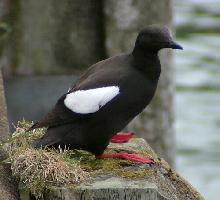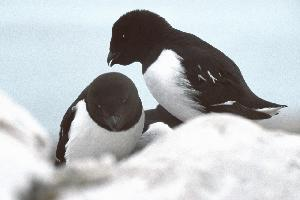
Poids et mesures
| Longueur | de 32 à 38 cm |
|---|---|
| Envergure des ailes | de 49 à 58 cm |
Description de l'animal
The Black Guillemot (Cepphus grylle) is a captivating species of seabird belonging to the auk family, Alcidae. This bird is distinctive for its striking plumage, intriguing behaviors, and specialized habitat preferences, making it a subject of interest for birdwatchers and ornithologists alike.Adult Black Guillemots are characterized by their predominantly black or dark brown plumage during the breeding season, which contrasts sharply with their white wing patches. These white patches are most noticeable in flight or when the bird fans its wings while swimming. Outside of the breeding season, their plumage transitions to a mottled grey and white, allowing them to blend more seamlessly into their winter marine environments. Regardless of the season, their bright red feet are a distinctive feature, adding a splash of color to their otherwise monochromatic appearance. The bird's bill is narrow and pointed, perfectly adapted for catching fish, and during the breeding season, it takes on a strikingly bright red hue.
Measuring approximately 30 to 38 cm in length, with a wingspan of 52 to 58 cm, Black Guillemots are medium-sized seabirds. They possess a robust body and strong wings, which enable them to dive and swim underwater with remarkable agility in pursuit of their prey. Their diet primarily consists of small fish, crustaceans, and mollusks, which they catch by diving from the surface and propelling themselves underwater using their wings.
Black Guillemots are found across the North Atlantic, from the eastern coast of North America to the western and northern coasts of Europe and as far east as the White Sea in Russia. They prefer rocky shorelines and islands where they can nest in crevices or under rocks, away from predators. Their nests are relatively simple, lined minimally with plant material, feathers, or whatever debris is available in their immediate environment.
Breeding pairs are monogamous, often returning to the same nesting site year after year. The female typically lays one to two eggs, which both parents then incubate. After the chicks hatch, both parents are involved in feeding and protecting them until they are ready to fledge. The strong bond between the breeding pair is maintained through various behaviors, including mutual preening and display calls.
The social behavior of Black Guillemots includes forming loose colonies during the breeding season, where their distinctive "high-pitched whistle" calls can be heard. These calls serve as communication between mates and also play a role in territorial defense. Outside of the breeding season, they are more solitary or found in small groups, often remaining close to their breeding sites.
Despite facing threats such as oil spills, pollution, and climate change, which impact their marine environment and food sources, the Black Guillemot has managed to maintain relatively stable population levels in many areas. However, continued monitoring and conservation efforts are essential to ensure the long-term survival of this species.
In conclusion, the Black Guillemot is a fascinating and resilient seabird, adapted to life in the challenging conditions of the North Atlantic. Its striking appearance, interesting behaviors, and the role it plays in the marine ecosystem make it an important species for biodiversity and a beloved subject of study and observation for those interested in the natural world.
Animaux similaires
Nouvelles photos d'animaux
Top 10 des animaux
- Dolphin gull (Leucophaeus scoresbii)
- Japanese macaque (Macaca fuscata)
- Stone loach (Barbatula barbatula)
- Greek tortoise (Testudo graeca)
- Russian tortoise (Testudo horsfieldii)
- Galápagos tortoise (Geochelone nigra complex)
- Diana monkey (Cercopithecus diana)
- Moustached guenon (Cercopithecus cephus)
- Common flying dragon (Draco volans)
- Galápagos penguin (Spheniscus mendiculus)


